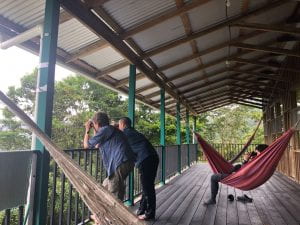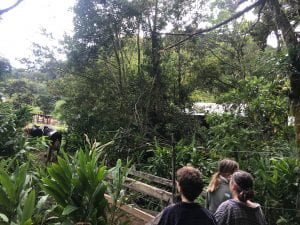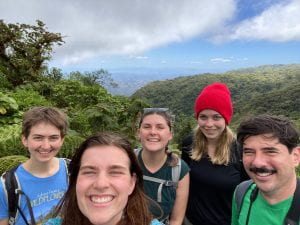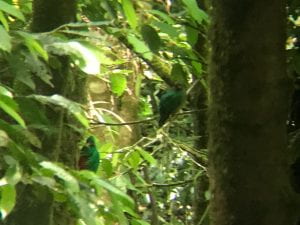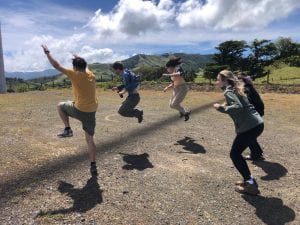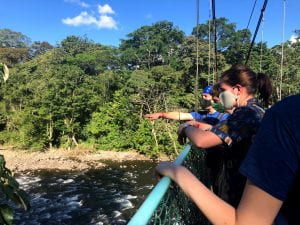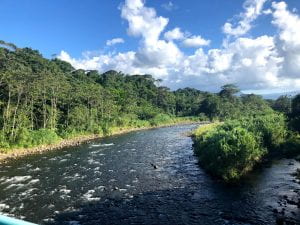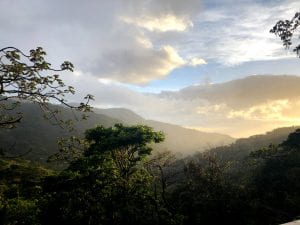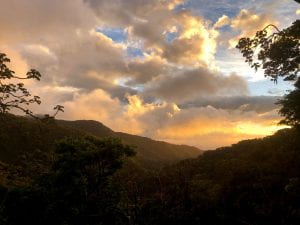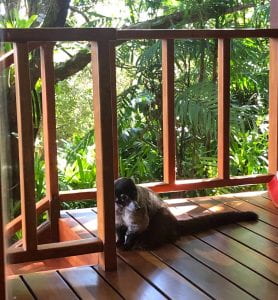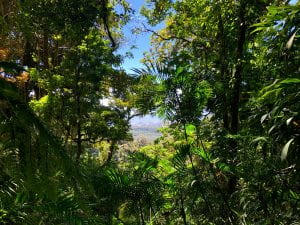We recently returned from our double-field-station field trip to San Gerardo and Palo Verde. Both beautiful places, and very different ecologically. San Gerardo was humid and cool, whereas Palo Verde was dry and hot. It was truly a wild experience to go straight from one to the other because my body barely had time to adjust. We spent our days hiking around to get a feel for the lifezone and learning the ins and outs of different species that lived there. We learned about 40 species within the 10 days of the field trip, and it was fascinating to learn about how each species has its own adaptations to the life zone and season that they live in. Our meals were filled with fits of laughter, and our nights filled with puzzling, guitar singalongs, and ping pong.
Every day that we were at San Gerardo I thought to myself: “I never want to leave here.” I looked out at the mountains full of forest, admiring the volcano in perfect view, and wished that those days would last forever. In order to get to the field station, you have to hike in, with all of your stuff on your back, down a steep hill that is almost 3 miles long. At the end, you hike all the way back up that 3-mile hill with a backpack filled with dirty clothes. Once I arrived at the parking lot at the top of the hill, shaking and sweating, I just wanted to roll all the way back down the hill and stay at the field station for another week. There was no wifi or electricity except for when they turned on the generator to cook meals. I loved the lack of electricity and wifi because it meant that I went to sleep early and wasn’t on my phone at all. The food was delicious, with so much variety and vegetarian options superior to anything I’ve ever had in my life. The showers were super cold, so we would run around the building to get sweaty before jumping into the shower. It was comical how everyone anticipated and feared the showers, but that was one of my favorite parts. Nothing beats a cold shower.
Another quirk of this field station (and Palo Verde, but not to the same extent) was that the walls were comically thin. The six of us were split into 3 rooms, all lined up right next to each other, but the way that sound traveled allows us to talk amongst ourselves as if we were all in the same room. One of my favorite moments of the trip was when we were all showering for the first time since we arrived there and I heard a loud and high-pitched shriek. Since Beth and Sylvie were in the bathroom next door, I thought that it was one of them so I said “yeah, it’s cold right?!” to which Beth replied, “uhh… yeah I guess.” I was confused about her response. A few minutes later when we were done showering, we went outside onto our shared balcony and we were talking about the shriek. One of our professors, Johel, poked his head out of their door to say “that was Branko’s shriek.” Branko is our other professor, and he has not since lived this moment down.
Later that night, we sat down to sing songs from “Alan’s songbook” while Branko played the guitar. Alan was previously involved with this program and is married to the current Program Director, so his personally crafted songbook has been used for many years of field station singalongs. There is a wide range of songs in Spanish and English, old and new, from many genres. Some songs are obnoxiously loud to sing, but they are so much fun that they always make an appearance in singalong nights. For example, we love to belt Celine Dion’s “My Heart Will Go On” every single time. As we were singing on the balcony, the people who run the field station came up to tell us that they had desert for us. Johel said, “They’re just giving us food so that we stop singing,” which led to a fit of laughter and joking about many different scenarios, each more ridiculous than the last, about how they could get us to stop singing. After that, they continued to call us downstairs for various things and every time it became a bigger joke that they were trying to shut us up.
And with that fun anecdote, I will sign off! More fun stories to come . . .
Bird watching from the balcony at San Gerardo

